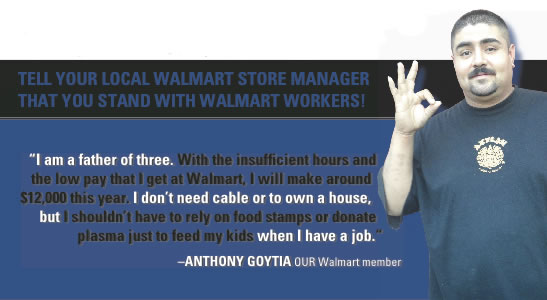

Share
Walmart workers will hold protests across the country on Black Friday, traditionally the busiest shopping day, to call on the retail giant to pay them at least $25,000 a year.
In Minnesota, more than 250 people are expected to demonstrate from 11 a.m. to 1 p.m. on Friday, Nov. 29, at the Midway Walmart store, 1450 University Ave. W., St. Paul.
The protests are being organized by OUR Walmart (The Organization United for Respect at Walmart), an organization of current and former Walmart workers. They will partner with groups in dozens of cities. In Minnesota, the protest will be held in association with the United Food and Commercial Workers, Minnesotans for a Fair Economy, and CTUL (Centro de Trabajadores Unidos en Lucha/The Center of Workers United in Struggle).
“We are calling to raise the wage. A full time wage needs to be at least $25,000 a year,” said Diana Tastad, organizer with OUR Walmart.
Tastad said she has been in communication with an employee in Brooklyn Center who is working full-time at $8.40 per hour yet she only made $12,000 last year.
“This is because ‘full-time’ does not mean 40 hours – it means 32 hours per week. And there is no contract, no guarantee,” said Tastad. A worker might get over 30 hours one week and 16 hours the next, a possible result of management retaliation, which is another point of protest to be voiced on Black Friday.
Taxpayers subsidize low wages
Aside from the effect on workers, low wages at stores like Walmart and Target have proven to take a large toll on the broader Minnesota economy as well. On Nov. 12, Minnesotans for a Fair Economy released At What Cost, a report detailing how taxpayers are subsidizing large corporations by paying for public assistance because employees cannot make ends meet.
The report shows that taxpayers pay more than $44.7 million dollars in public assistance annually for almost 5,850 employees in Minnesota Target locations. Well over 5,000 Walmart employees need more than $40 million in assistance. Adding all of the major corporations together, the total cost to taxpayers is over $150 million. The report concludes that if these 20,000 workers were paid a living wage to afford the basic necessities, the cost to taxpayers would be far lower.
This year, supporters of the Black Friday protests will have many online outlets to connect to the cause. Nationwide, people can visit BlackFridayProtests.org, type in their zip codes to find the nearest protest, RSVP online, and live stream the event on Nov. 29.
The website also has fliers and other material that can be downloaded. “Even if you cannot be a part of the organized events, you can plan your own rally and still be part of Black Friday and have an action against Walmart,” stated Tastad.
In addition, instantaneous news can be found on Twitter (@ChangeWalmart, @ForRespect, and #WalmartStrikers).
Ramping up pressure
Last Black Friday was the first time in Walmart history when workers went on an unfair labor practice strike. Over 500 Walmart workers nationwide walked off the job and employees from over 2000 Walmart locations held smaller protests. Workers demanded more transparency in their scheduling, more hours, and higher pay. In January, Walmart responded by promising to hire veterans, allow workers to pick up extra hours easily, and invest in the U.S. economy.
In June of this year, Walmart workers went on a two-week strike and attended a shareholders meeting. Two weeks later, Walmart fired 25 of more than 130 employees who went on strike. Collective action such as strikes is protected under federal labor law, but enforcement is weak and people rarely have the time or resources to contest these illegal actions.
“Walmart fires people all of the time for minor reasons. If they don’t like you, they can get rid of you. It’s not like a union where someone can grieve the process,” said Tastad.
In response, OUR Walmart organizers have filed Unfair Labor Practice charges with the National Labor Relations Board. To further put pressure on Walmart, workers held a Sept. 5 action in 15 cities across the United States.
On Nov. 6, southern California Walmart workers went on strike aiming for higher wages, more predictable schedules, and a stop to management retaliation. The next day, 54 Walmart employees and supporters were arrested for sitting in the street in protest in downtown Los Angeles.
“Last year, Walmart made $17 billion in profit, while their workers are making roughly $8.40 per hour, barely making ends meet. We are calling on Walmart to pay their employees a living wage,” said Diana Tastad.
The day after Thanksgiving once was a time for leftovers and relaxation but has since become a peak day for sales at retail stores throughout the U.S. According to At What Cost, the Black Friday weekend accounts for almost 9 percent of holiday season sales.
As of last year, Black Friday has also become a day for workers and supporters to organize for higher wages and a better workplace environment. It will be interesting to see how the rallies and protests in Minnesota and nationwide will unfold and if a new Black Friday tradition will stand up to the allure of low, low prices.

